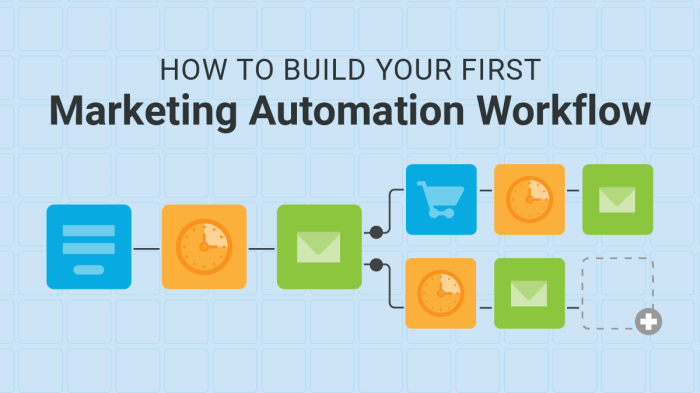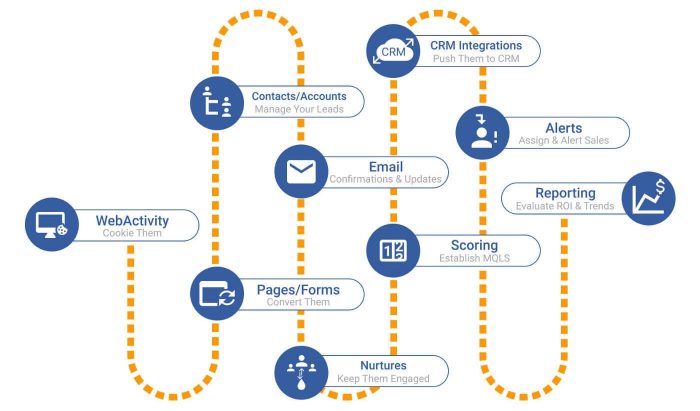Building a Marketing Automation Workflow sets the stage for revolutionizing how businesses operate and grow, diving into the intricate world of automated marketing strategies that drive success and efficiency. As we explore the ins and outs of this dynamic process, get ready to unlock the secrets to elevating your marketing game to new heights.
From unraveling the complexities of customer relationship management to crafting personalized content that resonates with your audience, this guide will equip you with the tools needed to thrive in the ever-evolving landscape of digital marketing.
Introduction to Marketing Automation Workflow
Marketing automation workflow is like having your own personal marketing genie that takes care of repetitive tasks, like sending emails or updating social media, so you can focus on the fun stuff like creating killer campaigns and engaging with your audience.
By implementing marketing automation in businesses, you can save time, increase efficiency, and personalize interactions with customers to drive better results. It’s like having a supercharged marketing team working around the clock for you!
Benefits of Implementing Marketing Automation
- Streamlined Processes: Marketing automation helps streamline repetitive tasks, making your workflow more efficient.
- Personalized Customer Interactions: By using data to personalize interactions, you can create targeted campaigns that resonate with your audience.
- Improved Lead Nurturing: Marketing automation can help nurture leads through the sales funnel, increasing conversion rates.
- Enhanced Reporting and Analytics: With marketing automation, you can track the performance of your campaigns and make data-driven decisions to optimize results.
Examples of Industries Benefiting from Marketing Automation Workflows
While marketing automation can benefit businesses across various industries, some sectors that can particularly benefit include:
- E-commerce: By automating email marketing and personalized recommendations, e-commerce businesses can drive sales and increase customer loyalty.
- Real Estate: Real estate agents can use marketing automation to nurture leads, send property updates, and schedule appointments, saving time and improving client relationships.
- Healthcare: Healthcare providers can use marketing automation to send appointment reminders, share educational content, and improve patient engagement.
- Technology: Tech companies can leverage marketing automation to nurture leads, provide product updates, and drive user engagement through personalized communication.
Components of a Marketing Automation Workflow

Marketing automation workflows require several key components to be successful. These components help businesses streamline their marketing efforts, engage with customers effectively, and drive conversions.
Customer Relationship Management (CRM) Systems
Customer Relationship Management (CRM) systems play a crucial role in marketing automation workflows. These systems help businesses manage and analyze customer interactions and data throughout the customer lifecycle. By integrating CRM systems with marketing automation platforms, businesses can create personalized marketing campaigns based on customer behavior and preferences.
Email Marketing
Email marketing is an essential component of marketing automation workflows. It allows businesses to send targeted and personalized emails to leads and customers at the right time. By automating email campaigns, businesses can nurture leads, promote products or services, and build relationships with customers effectively.
Lead Scoring
Lead scoring is another important component of marketing automation workflows. It involves assigning a score to leads based on their interactions with marketing campaigns and website activities. By prioritizing leads based on their score, businesses can focus their efforts on leads that are more likely to convert, resulting in higher sales and ROI.
Analytics
Analytics play a critical role in marketing automation workflows by providing insights into campaign performance, customer behavior, and ROI. By tracking and analyzing key metrics such as open rates, click-through rates, conversion rates, and customer engagement, businesses can optimize their marketing strategies, identify areas for improvement, and make data-driven decisions to achieve their marketing goals.
Designing a Marketing Automation Workflow: Building A Marketing Automation Workflow

When it comes to designing a killer marketing automation workflow, you gotta have a solid plan in place. This process involves mapping out the customer journey, identifying touchpoints, and creating personalized content that resonates with your audience at every stage.
Mapping Out Customer Journeys
To create an effective marketing automation workflow, you need to map out the different paths your customers can take from awareness to conversion. Identify key touchpoints where customers interact with your brand and tailor your content to guide them seamlessly through each stage of the journey.
- Start by defining your buyer personas and understanding their pain points and needs.
- Plot out the various stages of the customer journey, such as awareness, consideration, decision, and retention.
- Identify the touchpoints where customers are most likely to engage with your brand, such as email, social media, or your website.
Creating Personalized Content
Personalization is key when it comes to creating content for your marketing automation workflow. By delivering targeted messages that resonate with your audience, you can increase engagement and drive conversions.
- Segment your audience based on demographics, behavior, and preferences to deliver personalized content that speaks to their specific needs.
- Use dynamic content to tailor your messages based on where customers are in the buying journey.
- Test different messaging and content formats to see what resonates best with your audience and optimize your workflow for maximum impact.
Implementing and Testing the Workflow
Implementing a marketing automation workflow is crucial for streamlining your marketing processes and improving efficiency. It involves setting up the workflow in your chosen marketing automation platform, defining triggers, actions, and conditions, and ensuring that all elements work seamlessly together.
Importance of A/B Testing and Optimizing, Building a Marketing Automation Workflow
A/B testing is essential for optimizing your marketing automation workflow for better results. By testing different variations of your emails, landing pages, or messaging sequences, you can determine which elements perform best and make data-driven decisions to improve your overall strategy. It allows you to understand what resonates with your audience and refine your messaging for maximum impact.
- Run A/B tests on subject lines, email content, call-to-action buttons, and other key elements of your workflow.
- Monitor the performance of each variant and analyze the results to identify trends and patterns.
- Use the data gathered from A/B testing to make informed decisions about refining and optimizing your workflow for better engagement and conversion rates.
Measuring Success and Making Adjustments
Measuring the success of your marketing automation workflow is essential to track the effectiveness of your campaigns and make necessary adjustments to improve performance. Key metrics to consider include open rates, click-through rates, conversion rates, and overall engagement levels.
- Set clear goals and KPIs for your workflow to measure its success.
- Regularly analyze performance data and metrics to identify areas for improvement.
- Make data-driven decisions based on the insights gathered from your analytics to optimize your workflow for better results.